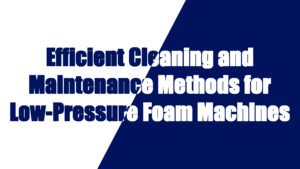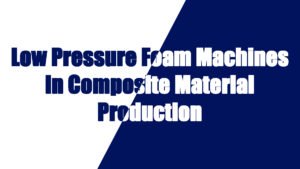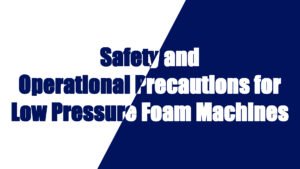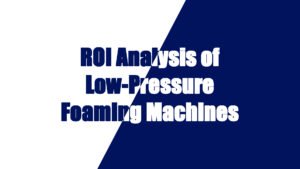The machine de coulée d'élastomère industry is undergoing significant transformation driven by advancements in technology and evolving market demands. From innovative injection systems and material mixing techniques to fast-curing technologies and intelligent control systems, these developments are enhancing production efficiency, product quality, and sustainability. This article explores key technological innovations in elastomer casting machine, such as new injection systems, smart mixing technologies, rapid curing techniques, and intelligent automation, and examines how these trends are shaping the global market landscape.
Advanced Injection Systems: Precision Meets Efficiency
The injection system is the core component of Machine de coulée de PU, directly influencing product consistency and production efficiency. Recent advancements in injection technology have focused on precision, speed, and material compatibility.
High-Precision Flow and Pressure Control
Traditional systems often rely on manual adjustments, which can lead to inconsistencies. Modern injection systems utilize servo-driven technology and closed-loop control systems, achieving a flow and pressure precision of up to 0.1%. This reduces material waste and ensures consistency, particularly for high-end products.
Multi-Component Injection Technology
To meet diverse market demands, multi-component injection systems now allow for precise mixing and injection of materials such as polyurethane (PU) and polyurea. These systems independently control the flow rates and temperatures of different components, accommodating varying densities, hardness levels, and properties.
Faster Injection and Molding Cycles
By optimizing the power transmission system, modern equipment has improved injection speed by 30%-50% compared to traditional systems. For example, some systems can complete an injection-molding cycle in just two seconds, ideal for large-scale, high-efficiency production.
Material Mixing Systems: From Uniformity to Intelligence
The uniformity of material mixing is crucial to elastomer production, directly affecting product performance and aesthetics. Innovations in mixing technology have emphasized intelligent and energy-efficient solutions.
Real-Time Mixing Monitoring
Equipped with high-precision sensors and intelligent monitoring modules, modern mixing systems can track temperature, speed, and mixing time in real time. Automatic adjustments ensure exceptional uniformity while minimizing human error.
Vacuum Degassing and Bubble-Free Mixing
Gas bubbles in traditional mixing processes can compromise product quality. Advanced mixing systems incorporate vacuum degassing technology, which removes air during mixing to produce dense and durable materials. This technology is especially beneficial for high-performance applications, such as automotive and aerospace components.
Energy Optimization
Modern systems feature optimized blade designs and high-efficiency motors, reducing energy consumption by 20%-30% compared to conventional equipment. For instance, some systems consume only 70% of the energy required by older models when mixing 30 kilograms of material.
Fast-Curing Technologies: Accelerating Production Cycles
Fast-curing technologies have revolutionized elastomer manufacturing by reducing production time while enhancing product quality.
Ultraviolet (UV) Curing
UV curing uses high-energy ultraviolet radiation to complete the curing process within seconds. This technology is highly energy-efficient and is widely adopted in applications such as electronics and medical devices.
Hot-Air Circulation Curing
By optimizing airflow distribution, hot-air curing systems achieve uniform heating and faster curing times. This method is particularly suitable for large molds or thick elastomer products, with efficiency improvements of over 40% compared to traditional curing methods.
Catalyst-Assisted Curing
The use of advanced catalysts in elastomer production accelerates chemical reactions, reducing curing times from 30 minutes to under 10 minutes. This significantly enhances production efficiency and is ideal for industries with high-volume demands.
Intelligent Control Systems: Driving Industry 4.0
Automation and intelligence are transforming machine de coulée d'élastomère, bringing benefits such as enhanced operational efficiency, predictive maintenance, and data-driven decision-making.
Adaptive Production Optimization
Smart control systems monitor equipment in real time and automatically adjust parameters to meet production requirements. For example, systems dynamically optimize injection speed, temperature, and pressure based on material properties, ensuring both high efficiency and consistent quality.
Predictive Maintenance
Integrated predictive maintenance features analyze historical performance data to identify potential issues before they cause downtime. This reduces unplanned outages and maintenance costs. Some systems achieve predictive accuracy rates of over 95% using machine learning algorithms.
Data-Driven Insights
Intelligent systems generate detailed production reports that help manufacturers optimize processes and resource allocation. For example, analyzing energy consumption and material usage across production batches can reveal inefficiencies and reduce costs.
Market Trends: Sustainability and Customization Driving Growth
The PU elastomer casting machine market is undergoing rapid technological transformation and demand upgrades, with market trends focusing on green sustainability and personalized customization. Below is an in-depth analysis of these trends:
Sustainability as the Mainstream Trend
As global attention to carbon neutrality intensifies and environmental regulations tighten, the PU casting machine industry is accelerating its transition towards green manufacturing and low-carbon emissions.
Eco-Friendly Materials and Solvent-Free Processes
- Advancements in Eco-Friendly Materials: More manufacturers are supporting renewable raw materials and bio-based polymers in their equipment. For instance, some companies have developed systems compatible with bio-based polyurethane to reduce reliance on fossil fuels.
- Solvent-Free Processes: Traditional elastomer production often involves solvents that can harm the environment. New equipment employing solvent-free processes, such as high-pressure injection systems and vacuum mixing technology, significantly reduce volatile organic compound (VOC) emissions—up to 80% compared to traditional solvent-based methods.
Energy Optimization and Recovery Technologies
- Energy Recovery Systems: Many machines integrate heat recovery technologies to reuse excess heat generated during production for other processes, increasing energy efficiency by over 30%. For instance, some equipment repurposes waste heat to support mixing and curing units, reducing overall production costs.
- Low Energy Consumption Designs: With high-efficiency motors, smart servo systems, and optimized machine designs, next-generation elastomer casting machineconsumes 20%-50% less energy than traditional machines. This not only lowers the carbon footprint but also boosts long-term economic benefits for manufacturers.
Compliance with International Environmental Standards
- Manufacturers are increasingly focusing on obtaining environmental certifications such as REACH, RoHS, and ISO 14001. Equipment that meets these standards is more competitive globally and helps customers comply with stringent regulations. Research indicates that certified equipment achieves a 30% higher sales growth rate compared to uncertified models.
Customization to Meet Diverse Needs
With the rising demand for high-end elastomer products, equipment manufacturers are striving to meet diverse production requirements through customization and modular designs.
Flexible Configurations and Modular Designs
- Modular Equipment: Modern elastomer casting machineallows customers to select specific modules, such as injection systems, mixing units, or curing units, based on their needs. For small and medium-sized enterprises, cost-effective modular equipment is ideal, while large-scale manufacturers can opt for high-efficiency automated production lines. Modular designs also simplify upgrades and maintenance, reducing initial investment costs.
- Multi-Functional Equipment: Some equipment supports cross-material production, enabling quick switching between products with different hardness, colors, and densities. For example, certain machines feature quick-change systems that allow material transitions in under 30 minutes, suitable for both small batches and large-scale production.
Driving Forces Behind Customization
- Small-Batch, High-Precision Production: The demand for small-batch, high-precision elastomer products (e.g., medical devices, aerospace components) is increasing. Manufacturers are developing high-precision injection systems and intelligent mixing technologies to cater to these high-end markets. Some machines can produce with a minimum injection volume of 1 gram, ideal for laboratory-scale R&D.
- Industry-Specific Requirements: Different industries (e.g., automotive, construction, electronics, and defense) have unique production needs. Many manufacturers offer tailored services, such as integrating specific temperature control features, corrosion-resistant components, or specialized production processes, to better meet the demands of specific industries.
Intelligent and Data-Driven Customization
- By incorporating smart control systems and IoT technologies, customized equipment can not only meet production needs but also optimize operations based on real-time usage data. For instance, some manufacturers offer cloud-based data services that enable customers to remotely monitor equipment performance and adjust production parameters for true personalized manufacturing.
Diversified Global Market Demand
The Rise of Emerging Markets
- With the rapid industrialization of regions like Asia-Pacific, Africa, and Latin America, demand for elastomer casting machinein these markets is growing rapidly. The Asia-Pacific market, for example, is expected to lead global growth with an annual increase of 8% over the next five years. Manufacturers are expanding their presence in these regions by offering cost-effective solutions and localized services.
Innovation Driven by High-End Markets
- In mature markets such as North America and Europe, the demand for high-performance elastomer products (e.g., high-precision seals and impact-resistant materials) is driving innovation in equipment technology. Studies show that the demand for intelligent, energy-efficient, and high-precision equipment in these markets is growing at a rate exceeding 15%.
Accelerated Equipment Upgrades for Sustainability
- Many industries are accelerating the replacement of outdated equipment to meet sustainability goals. For example, the automotive industry is increasing its demand for elastomer casting machinethat complies with energy-saving and environmental standards, prompting manufacturers to develop greener production technologies.
Technological advancements in elastomer casting machine are reshaping the industry, driving improvements in production efficiency, product quality, and environmental sustainability. Innovations in injection systems, material mixing, curing technologies, and intelligent controls are enabling manufacturers to meet the demands of a dynamic market. As the industry evolves, the emphasis on sustainability and customization will further accelerate growth, ensuring that elastomer casting machine remains at the forefront of modern industrial manufacturing.




































